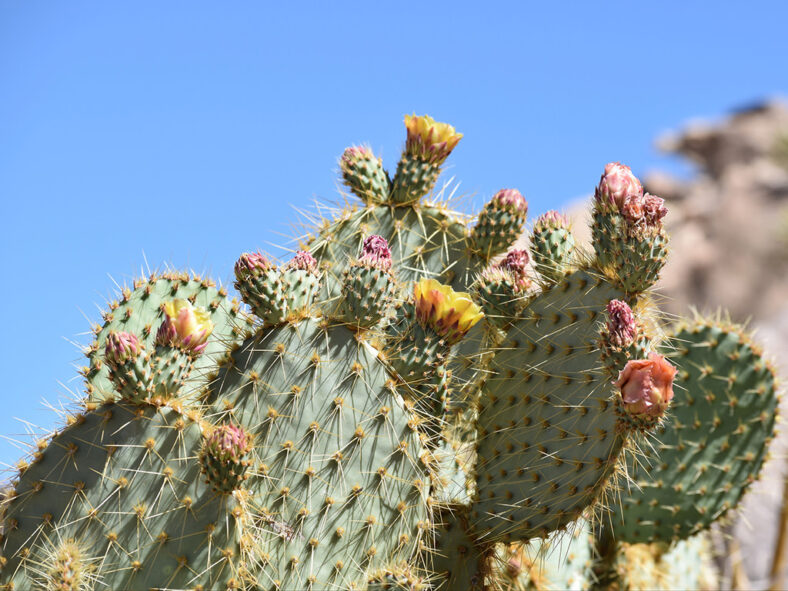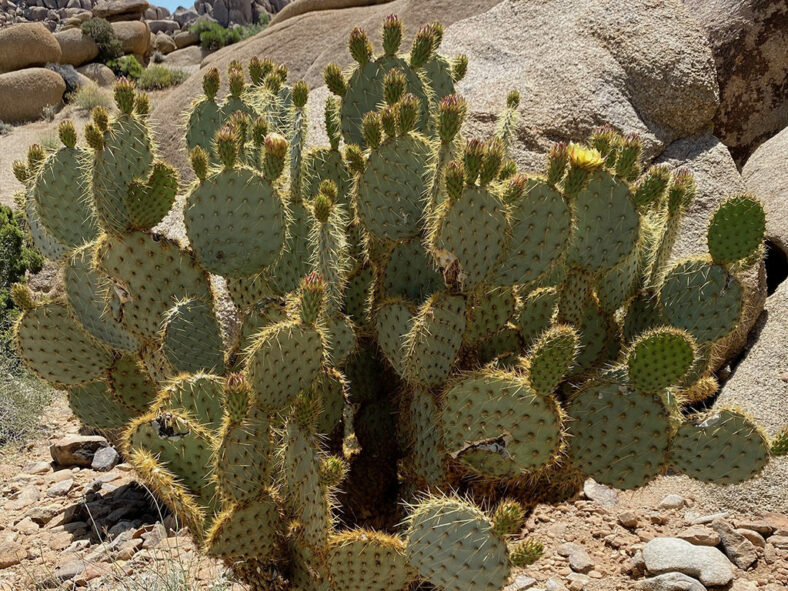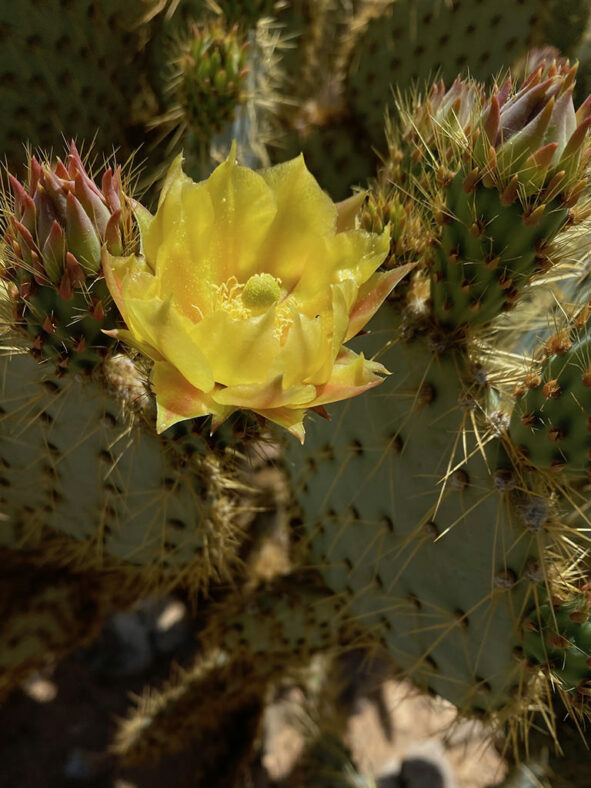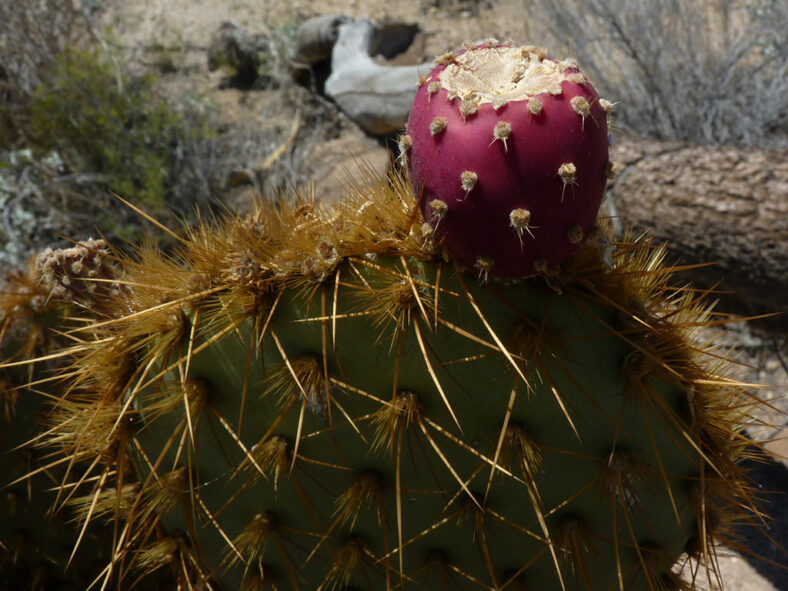Opuntia chlorotica, including Opuntia gosseliniana and Opuntia santa-rita, is one of three varieties within the Opuntia chlorotica complex, as described by David J. Ferguson in 1988.
Scientific Name
Opuntia chlorotica Engelm. & J.M.Bigelow
Common Names(s)
Dollar-joint Prickly Pear, Flapjack Prickly Pear, Pancake Prickly Pear
Synonym(s)
Opuntia palmeri, Opuntia tidballii
Scientific Classification
Family: Cactaceae
Subfamily: Opuntioideae
Tribe: Opuntieae
Genus: Opuntia
Etymology
The specific epithet "chlorotica" (pronounced "klor-OH-tih-kuh") means "greenish-yellow, pale green" and refers to the color of the stigma lobes.
Origin
Opuntia chlorotica is native to the United States. It typically grows in well-drained, rocky soils, sometimes between boulders or on cliff faces in California, Nevada, Utah, Arizona, and New Mexico.
Description
Opuntia chlorotica is a shrubby or tree-like cactus with a spiny, well-defined trunk and branches that consist of joined blue-green, flattened segments called pads. It can grow up to 8.2 feet (2.5 m) tall. The pads are obovate to circular with areoles arranged in diagonal rows and can measure up to 8.4 inches (21 cm) long and 7.6 inches (19 cm) wide. The spines are either absent or usually present only in distal areoles, but they can also often be evenly distributed over the entire pad. They are yellow, aging to red-brown or blackish, and can be straight or weakly curved, growing up to 1.8 inches (4.5 cm) long. The glochids are crowded in a narrow crescent along the adaxial margins and can become prominent and robust on older pads. They are yellow, aging to reddish brown, and can grow up to 0.6 inches (1.5 cm) long.
From mid-spring to early summer, Opuntia chlorotica produces yellow flowers, sometimes with a pale red blush on the interior near the base of the tepals. They can reach up to 0.5 inches (1.2 cm) in diameter. The fleshy, spineless fruits are red and barrel-shaped and can grow up to 2.4 inches (6 cm) long and 1.6 inches (4 cm) in diameter. They contain colorless pulp and yellowish seeds.

How to Grow and Care for Opuntia chlorotica
Light: Opuntia chlorotica thrives in full sun, but some shade during midday and afternoon can prevent sunburn in hot climates. When grown indoors, it works best in a window that receives sunlight for 6 hours a day.
Soil: This cactus requires a well-draining soil mix. You can use a commercial cactus potting mix or create your own.
Temperature: Opuntia chlorotica is highly tolerant of high temperatures and prefers cooler temperatures in winter. It grows best in USDA Plant Hardiness Zones 8b to 11b, with average minimum winter temperatures ranging from 15°F to 50°F (-9.4°C to 10°C).
Watering: From spring to fall, water moderately and let the soil dry out completely before watering again. In most areas, rainfall will be enough for established plants. If potted, never let the container sit in water. Suspend watering during the winter.
Fertilizing: Opuntia chlorotica does not need fertilizer when planted in the ground. However, it will benefit from fertilizing when grown in a container during the growing season. Apply a water-soluble fertilizer. Suspend feeding during the winter when the plant goes dormant.
Repotting: Repot only when the cactus becomes potbound or is too large and unstable in its container. Choose a slightly larger container with drainage holes at the bottom. The best time for repotting is late winter or early spring.
Propagation: Opuntia chlorotica can be propagated by stem segments or seeds. The easiest method is using stem segments, which yields faster results. For best results, take the stem segments in early summer and sow the seeds in late spring.
Learn more at How to Grow and Care for Opuntia.
Toxicity of Opuntia chlorotica
Opuntia chlorotica is not toxic to humans or pets. However, it is best to keep this plant away from pets and children, as its harmful spines and glochids may cause skin irritation.
Links
- Back to genus Opuntia
- Succupedia: Browse succulents by Scientific Name, Common Name, Genus, Family, USDA Hardiness Zone, Origin, or cacti by Genus
Photo Gallery
Click on a photo to see a larger version.


